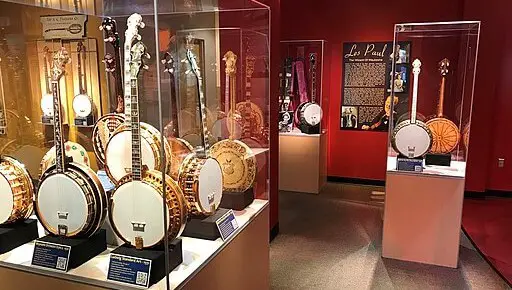American Banjo Museum
It doesn’t matter if you play the banjo, or any instrument at all for that matter. Anyone is able to appreciate the fascinating history of this fine instrument. This museum has the biggest public collection of banjos world-wide. With over 21,000 square feet, you’ll discover hundreds of instruments, recordings, printed music, memorabilia, and more – all related to the banjo.
The museum was first created in 1998 in the small town of Guthrie, just north of OKC about 30 miles. It was originally called, “The National Four-String Banjo Hall of Fame Museum” by co-founder and local lawyer, Brady Hunt, and second co-founder and Industrialist from Indiana, Jack Canine. The Museum, now called, the “American Banjo Museum, can be found in Bricktown, downtown Oklahoma City.
There are many reproductions of banjos that are hard to find now, which you’ll see at this place, including primitive ones originally created by African slaves, as well as banjos from the Classic Era and post World War II.
Some of the more popular banjos you’ll see are the ones from the American Jazz Age in the 20’s and 30’s, which form a core piece of the museum’s collection.
Some Exhibits to Explore at the Museum
The ABM is home to interpretive exhibits that allow you to learn about the history of the banjo. As you walk through the galleries on both floors, you’ll find yourself enamored with the vast array of banjos on display.
AMERICA’S INSTRUMENT
The banjo’s roots are described this 8 minute exhibition, which explains the advancement of this amazing instrument. The exhibit provides an interesting look at how they changed over time, and how it has remained a popular part of American culture.
THE 1920S
In the 20’s and 30’s, the banjo had reached a level like never before. Here, you’ll see some of the greatest players, as well as some important events, which occurred in the decade.
THE LEARNING LOUNGE
Visitors can watch videos on how to play the banjo in the Learning Lounge; and if you feel inclined to do so, you can even pick one up and pick away as you learn from the teachers in the educational videos.
THE CLASSICAL ERA
There were great efforts in the 1880’s to change the category of the instrument into a classical instrument, just like the violin. Professional classical musicians were bringing their banjos to the concert halls, and they wanted to ensure their instruments reflected their reputation. Much of the banjos in this exhibit show the great advances that happened in this era.
THE MINSTREL ERA – FROM THE PLANTATION TO THE STAGE…
In this era, the you can see how the banjo started to break away from its origins of simply being a handmade instrument used by the “folk” people. It was during this time that innovation and new design began to catch on. This exhibit provides an in-depth look at how changes in society shaped the history of the banjo. Featuring a variety of artifacts, documents, and multimedia presentations, the exhibit offers visitors a unique chance to explore the evolution of this instrument over time.
Some Things to Know Before You Go
How much time should I allow?
The museum tours take about an hour to experience. Groups of 15 or more should call ahead to make reservations.
Accessibility for Visitors with Disabilities
The facility is designed to accommodate anyone with a disability. They have an elevator onsite for anyone that wishes to use. They also have an ramp on the west side for wheelchair access. The exhibits can be experienced by both visually and hearing-impaired individuals.
Parking
Metered street parking is available during the week for visits less than 2 hours. It’s free to to park on Sundays, or if you have a valid disabilities placard or license plate. You can also choose to pay for all day parking in the lot behind the museum.
Health Precautions
Please keep in mind that they do have health guidelines in place. You can visit their website for those specific details.
Directions & Contact Info
9 East Sheridan Ave Oklahoma City, OK 73104
405-604-2793
https://americanbanjomuseum.com































